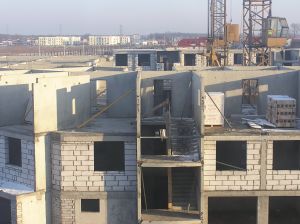The Commerce Department data released on August 19 suggests that, looking at a rolling 12-month total of multifamily starts without any seasonal adjustment, construction has hit its highest level since 1989 for the year ending in July.
This is less significant for economic growth than single-family homes, which have a bigger multiplier effect on both consumer spending and job growth, the Wall Street Journal reports.
“We will take what economic activity we can get, but our housing market model was designed in the U.S. to build a lot of single-family homes for owners, not multifamily homes for renters,” Diane Swonk, chief economist of Mesirow Financial, wrote Tuesday on the company's blog.
The boost to apartment construction, however, suggests that job gains are encouraging the creation of households, and that consumers' needs will require more construction, both for renters or for owners.
Renting has become popular, at least in part, because many Americans cannot afford the down payment for a house or can't get a mortgage, and others prefer the flexibility that comes with a lease.
Soon, however, rising rents could encourage renters to buy homes. A Labor Department report notes that rents were rising at their fastest pace in five years this July, up 3.3% from last year.
With apartment construction hitting a 25-year high, it's not surprising that apartment company stocks have been doing well. Shares of Equity Residential (EQR -0.13%) and AvalonBay Communities (AVB +0.22%) closed Tuesday at their highest levels since 1993 and 1994, when the companies went public, respectively.
Related Stories
| Aug 11, 2010
ZweigWhite names its fastest-growing architecture, engineering, and environmental firms
Management consulting and research firm ZweigWhite has identified the 200 fastest-growing architecture, engineering, and environmental consulting firms in the U.S. and Canada for its annual ranking, The Zweig Letter Hot Firm List. This annual list features the design and environmental firms that have outperformed the economy and competitors to become industry leaders.
| Aug 11, 2010
SSOE, Fluor among nation's largest industrial building design firms
A ranking of the Top 75 Industrial Design Firms based on Building Design+Construction's 2009 Giants 300 survey. For more Giants 300 rankings, visit http://www.BDCnetwork.com/Giants
| Aug 11, 2010
Guggenheim to host live online discussion of Frank Lloyd Wright exhibition
The Solomon R. Guggenheim Museum launches the Guggenheim Forum, a new series of moderated online discussions among experts from a variety of fields that will occur in conjunction with major museum exhibitions.
| Aug 11, 2010
Best AEC Firms of 2011/12
Later this year, we will launch Best AEC Firms 2012. We’re looking for firms that create truly positive workplaces for their AEC professionals and support staff. Keep an eye on this page for entry information. +
| Aug 11, 2010
Report: Building codes and regulations impede progress toward uber-green buildings
The enthusiasm for super green Living Buildings continues unabated, but a key stumbling block to the growth of this highest level of green building performance is an existing set of codes and regulations. A new report by the Cascadia Region Green Building Council entitled "Code, Regulatory and Systemic Barriers Affecting Living Building Projects" presents a case for fundamental reassessment of building codes.
| Aug 11, 2010
Call for entries: Building enclosure design awards
The Boston Society of Architects and the Boston chapter of the Building Enclosure Council (BEC-Boston) have announced a High Performance Building award that will assess building enclosure innovation through the demonstrated design, construction, and operation of the building enclosure.
| Aug 11, 2010
Portland Cement Association offers blast resistant design guide for reinforced concrete structures
Developed for designers and engineers, "Blast Resistant Design Guide for Reinforced Concrete Structures" provides a practical treatment of the design of cast-in-place reinforced concrete structures to resist the effects of blast loads. It explains the principles of blast-resistant design, and how to determine the kind and degree of resistance a structure needs as well as how to specify the required materials and details.







